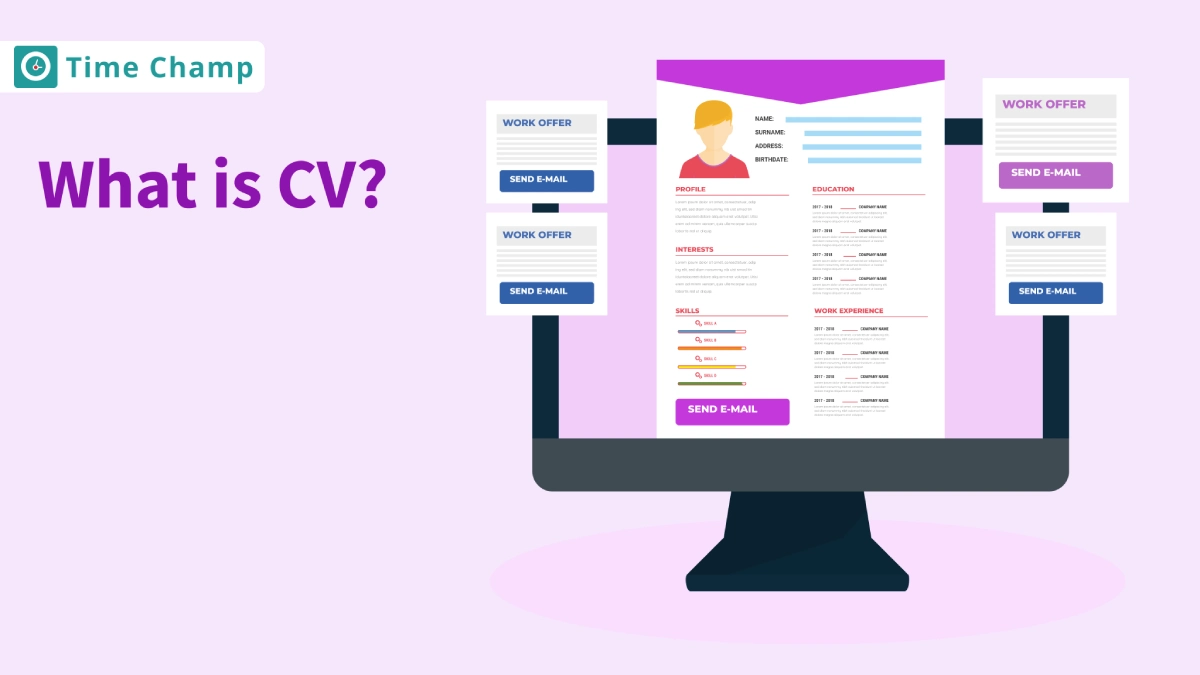What is a CV?
A CV, or Curriculum Vitae, is a detailed document that showcases an individual’s professional background, including their qualifications, work history, education, skills, achievements, and other pertinent details. It is often used when applying for jobs, academic positions, or grants, providing employers or institutions with a detailed overview of a candidate’s background. Unlike a resume, which is typically concise, a curriculum vitae is more detailed and can span multiple pages, particularly for those with extensive experience or academic credentials.
CV vs. Resume
In the United States and most of Europe, a CV and resume are not the same. A resume is a brief document that gives a quick summary of your past jobs, skills, and education. (The word “résumé” in French means “summary” or “overview.”)
A CV is usually longer and gives more details, mainly about your education, such as the courses you’ve taken and any research you’ve done.
In countries such as India and South Africa, the terms resume and CV are often used interchangeably.
What to Include in a CV (Curriculum Vitae)?
The details included in a CV can vary from one person to another. Some people may choose to only add information that is relevant to the job they are applying for. Here are the usual parts of a curriculum vitae:
1. Personal Information
At the top of the CV, include your name, phone number, email address, registered mail address, etc.
2. Education
Your education section should list the programs you’ve completed, starting with the most recent. Include the name of the institution, the degree you earned or are working towards, the courses you studied, and your graduation date (or expected graduation date). Be sure to include information on your college, graduate school, and any post-graduate education you’ve completed.
3. Work Experience
In the work experience section, write down your most recent jobs to those related to the job you are applying for. For each job, include your job title, the name of the company, the dates you worked there, and a short description of what you did and achieved.
4. Skills
In this section, list any skills you haven’t mentioned elsewhere in your CV. Include technical skills like knowing different languages, using computers or software, or driving. You can also add soft skills like working well with others or good communication. Make sure the skills you list match the job you’re applying for.
5. Achievements and Awards
Add any awards you’ve received from school or work. These can include honors like dean’s list, honorary degrees, presidential awards, professional certifications, or awards from employers for excellent performance.
6. Extracurricular Activities
Mention any extracurricular activities, volunteer work, or leadership roles you’ve taken on, as they show your interests and values. These experiences can highlight your teamwork, dedication, and ability to take initiative.
7. Presentations and Publications
If you have published academic or conference papers, include them in this section. List papers you’ve written individually, co-authored, or contributed to. Don’t forget to list the paper’s name, the year it came out, and any co-authors, if needed.
Tips for Writing a CV
- Pick clear fonts such as Arial or Calibri, with the same size and dark colors.
- Your CV should ideally be limited to two A4 pages. Try to maintain conciseness and clarity throughout the form.
- Select a format that you prefer, for instance, a chronological order (timeline) or a skills-based (functional).
- Make sure to use active verbs when you’re sharing your skills and achievements.
- Use bullet points and short sentences to make the information clear.
- You can also add icons to the headings.
- If your current email isn’t appropriate for work, consider creating a new one.
- Read the CV carefully and ensure it is free of spelling mistakes while keeping right up with the language.
- Get a copy of your CV reviewed by friends, a mentor, or even a career advisor for any suggested improvements.
How to Format Your CV?
Organizing your CV requires arranging the information logically and attractively. You can automate the process with the help of a CV template, or create your own from scratch.
Here’s a simple guide:
1. Choose the Right Layout
Use a clean, organized layout with consistent headings and a simple, readable font. Avoid fancy fonts or colors that distract from the content.
2. Keep Your CV to One Page
A one-page CV helps the employer easily go through important information about the candidate. Make bullet points simple with words and add numbers (e.g., “Made sales better by 10%”). Include only work, skills, and education that fit the job. A short and clear CV stands out.
3. Keep it Consistent
Use the same font, color, and size for everything. This makes your CV look organized and professional. (Skip fonts like Comic Sans.)
4. Get the Spacing Right
Make sure there’s space between sections and lines to keep your CV neat. Too much space or large margins can make it look weird.
5. Use Clear Section Headings
To make your CV more convenient, it is better to divide it into sections using headings. Ensure to set them apart by using a higher font size, preferably 14 or 16, and make the text bold. This makes each section stand out and makes it easier to read through your CV.
6. Name Your CV Properly
Don’t leave the file as “Document 1.” Save it with a name like “Joe-Smith-CV” to make it easy to recognize and look professional.
Frequently Asked Questions
The reverse-chronological format is considered the best structure for a CV because it highlights your most recent and relevant experiences first. This format helps hiring managers look at the latest skills and work experience and see how your experience has evolved over time.
A CV should always be typed. A typed CV is easier to read, looks more professional, and is simple to organize. Handwritten CVs are usually not appropriate for job applications.
Most countries, especially the United States and the UK, don’t require a photo on your CV, and in fact, it’s often discouraged to avoid any bias. However, in places like Germany and parts of Europe, adding a photo to your CV is more common and may even be encouraged.
If you have gaps in your work history, don’t be afraid to be upfront about them. In your CV, you can briefly explain the reason such as, ‘Took time off to help family’ or ‘Went back to study.’ Mention about what you learned and how it helped you get ready for your next job.




